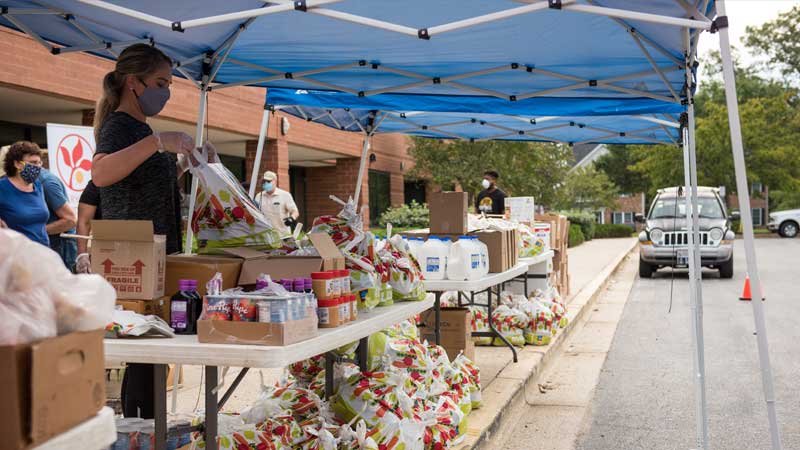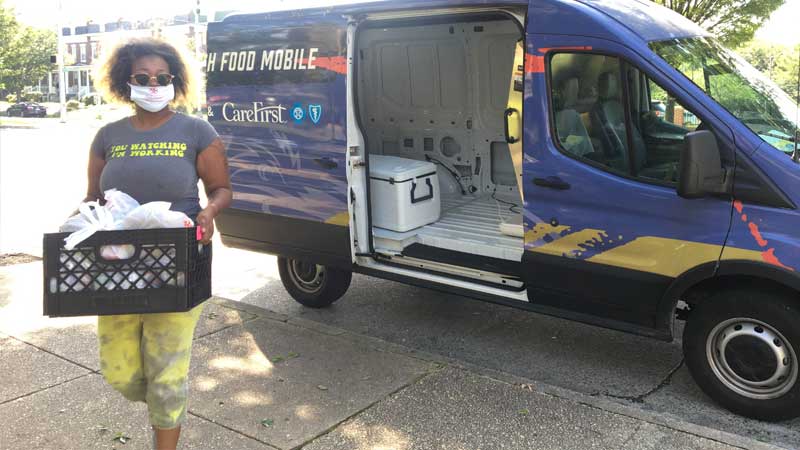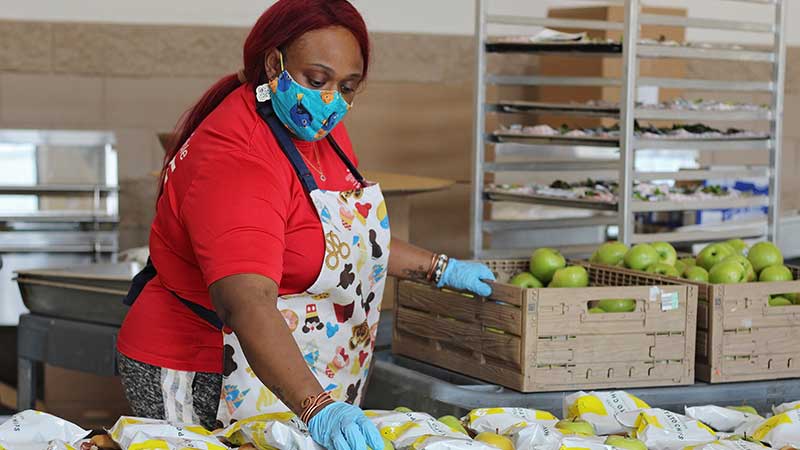Transitioning Kids Back to School

The widespread closure of schools in Spring 2020 left staggering numbers of kids vulnerable, given the fact that so many rely on schools as their main source of food throughout the day. A closure that was initially intended to last only a few weeks turned into a continuous nightmare for food-insecure families, unsure of how they would provide extra food for their kids.
Yet despite school closings throughout the COVID-19 pandemic, the Maryland Food Bank continued to prioritize the needs of children by implementing our MFB Kids initiative to end childhood hunger in new and different ways. This initiative encompasses several programs (like the School Pantry Program, Summer Clubs, and Supper Clubs) to ensure children in need have consistent access to good, nutritious food.
This fall, for the first time since the pandemic started, children across Maryland are heading back to in-person schooling in large numbers. While school districts across the state experiment with safely and efficiently welcoming students back, our MFB Kids partners are figuring out how to do the same.
Preparing for the School Year
Since 2010, the School Pantry Program has been the flagship of our MFB Kids initiative, helping ensure low-income, vulnerable children have access to the nutrients needed to support their healthy development. And while the pandemic severely threatened the practicality of running this program inside school buildings, we helped our partners pivot and promoted social distancing, outdoor distribution, and pre-bagged food.
“Every month, the school center sends me mail about food being given away by the food bank and I make sure that I come. It is very helpful for me and my children. Since COVID started, my husband is not working but this takes away a lot of the pain from me. I cannot say thank you enough.”
This fall, the agility continues as school pantries will have more autonomy around which way they’d like to distribute food. We have given schools the choice of one (or a combination of both) of the following School Pantry Program distribution models:
- Traditional School Pantry: Prior to the pandemic, all school pantries operated inside partner schools where many students are eligible for free and reduced priced meals, giving kids and parents direct access to shelf-stable grocery items from their schools. Because most of these schools have the capacity to store foods for longer periods of time, oftentimes, in-demand foods like meats and dairies can be distributed within this model as well.
- Outdoor Pantry on the Go Model: The default practice of school pantry distributions over the last year and a half, this model allows schools to sharply reduce person-to-person contact while still taking care of people’s needs. This model also offers same-day distribution, removing any need for a school to worry about long-term food storage.

Back to After School
We know that kids are always in need of nutritious meals – not just during school hours. But for many, the breakfasts and lunches received from schools are their only guaranteed meals throughout the day. So aside from school pantries, MFB’s Supper Club Program, which is held at local after-school sites, has been an additional resource keeping kids fed throughout the school year.
Because many Boys & Girls Clubs, recreational centers, and other places where supper clubs are held were shut down last school year, we offered Grab & Go meals that children and families could pick up outside these distribution sites and consume at home. These meals typically contained sandwiches, a snack, and a fruit, but the hope is that this school year, our FoodWorks team can return to preparing hot meals for kids at after-school programs.
“Grab & Go meals have been very important for hungry kids during the pandemic,” MFB’s Meals Program Director, Kelly Salters said. “And while they serve their purpose, my ultimate goal is to get back to our FoodWorks chefs preparing hot meals to be served to these kids. Hot meals are very appetizing and nutritious, and the kids love them.”
As long as schools and after-school programs remain open, serving hot meals remains a very practical possibility for our supper clubs this fall. It is our hope that these updates to our programs will make for a seamless back to school transition, but in order to truly help kids in need, we must prioritize nutrition.

What’s New this School Year
While distributing as much food as possible to children and families remains our main priority, we realize that it’s not just about the amount of food distributed – the nutritional quality of that food is just as, if not more, important.
To prioritize nutrition in schools this year, we are introducing the Supporting Wellness at Pantries (SWAP) initiative to all our school pantry partners. SWAP uses an easy-to-follow “stoplight” system of ranking food based on its nutrition level. Food that enters the doors of our warehouse gets assigned a color (green, yellow, or red) according to its nutritional content, like levels of sodium, saturated fat, and sugar. Green indicates “choose often,” yellow represents “choose sometimes,” and red signifies “choose rarely.” This system makes it easy for our partners to select healthy foods that kids will enjoy when ordering food from MFB’s online menu for their pantries.

We are also making strides in increasing visibility and access to farm-fresh fruits and vegetables for our school pantries. We are re-introducing schools to our Marketplace at the MFB warehouse, providing school pantry coordinators the option to order and pick up fresh produce that they know the kids they serve will enjoy, directly from our facility. Increasing this access to nutritious foods can be one of the deciding factors of a child’s ability to live a happy, healthy life.
A Crucial Time for Kids in Need
The adolescent years of a person’s life are some of the most crucial stages of development that we experience. These are the years where habits are made, information is retained, and the foundation of who children will grow up to become is established.
Hungry children often have a harder time concentrating in schools and focusing on learning, running a greater risk of stunted development. It can affect their grades, behavior, language and motor skills, physical health, and have many other negative consequences on their lives due to circumstances out of their control.
Battling these consequences that were further amplified throughout the pandemic is what keeps us motivated to feeding children and working to keep them from perpetuating generational cycles of poverty and food insecurity.
“The Maryland Food Bank is a good help for people with kids,” says Vastine G., a single grandmother with custody of her 13-year-old granddaughter. “I receive about $422 a month from disability, which goes utilities and bills first. But then I have to pay out of pocket for food. Receiving healthy foods from the pantry has been very positive for me and my family.”
Our MFB Kids programs have a major impact on parents and guardians like Vastine, who are doing their best to provide for the kids in their home but need additional assistance. No child should be forced to wonder where their next meal will come from, and as we face a school year bound to have its share of challenges, we rely on our donors to help us continue running programs that support the well-being of kids in need.
We Need Your Help
Programs, campaigns, and educational outreach at the Maryland Food Bank has always relied on the philanthropic support of charitable individuals like you.
Much like our food distribution efforts, outreach activities at the Maryland Food Bank rely on generous donations of money and time.
We hope you’ll consider a contribution.





